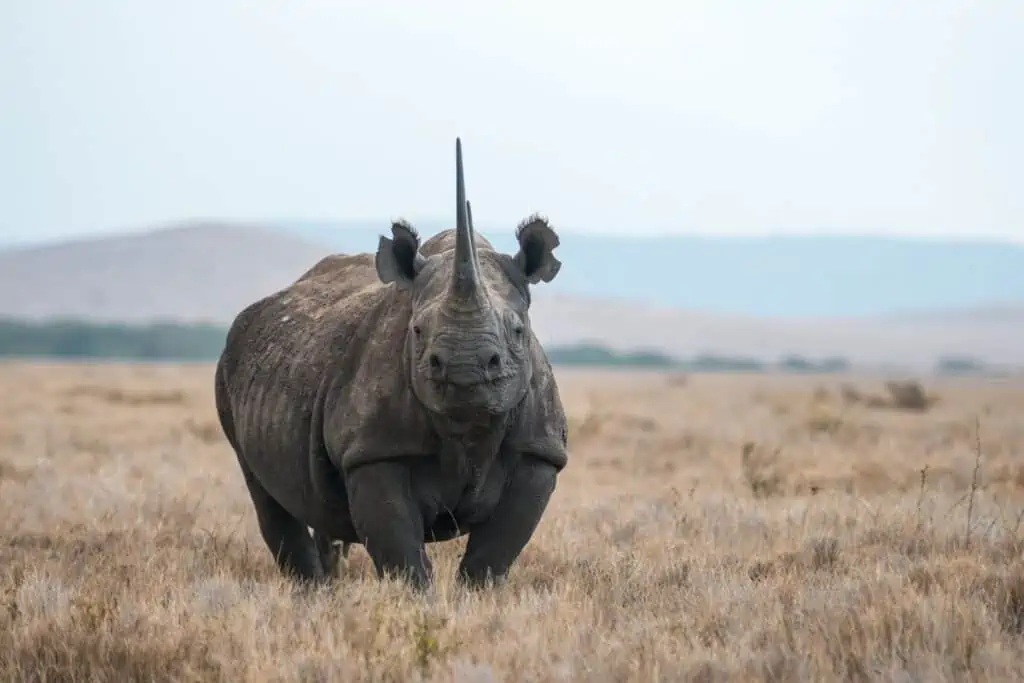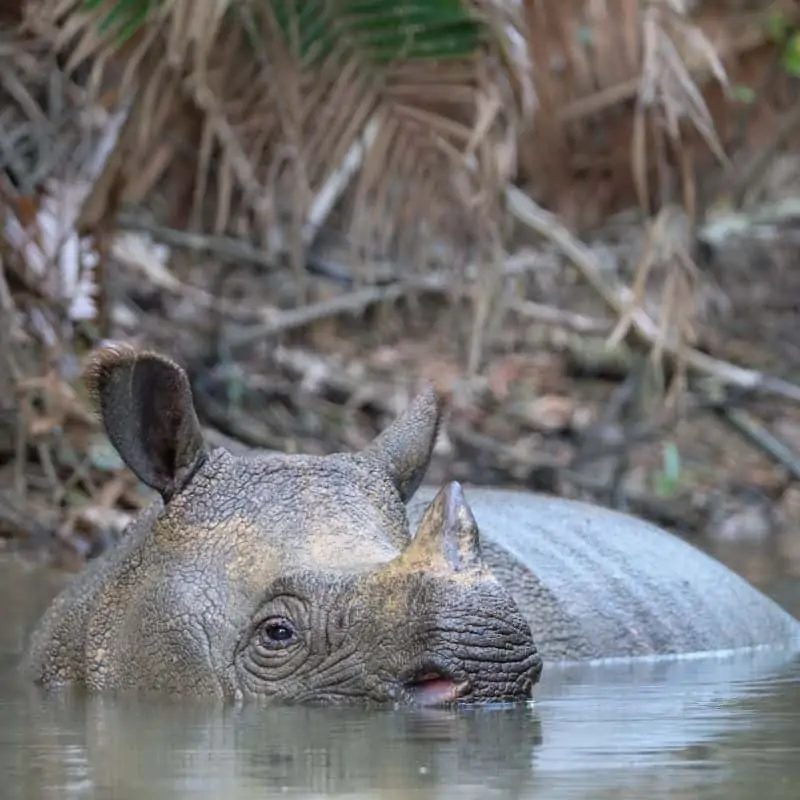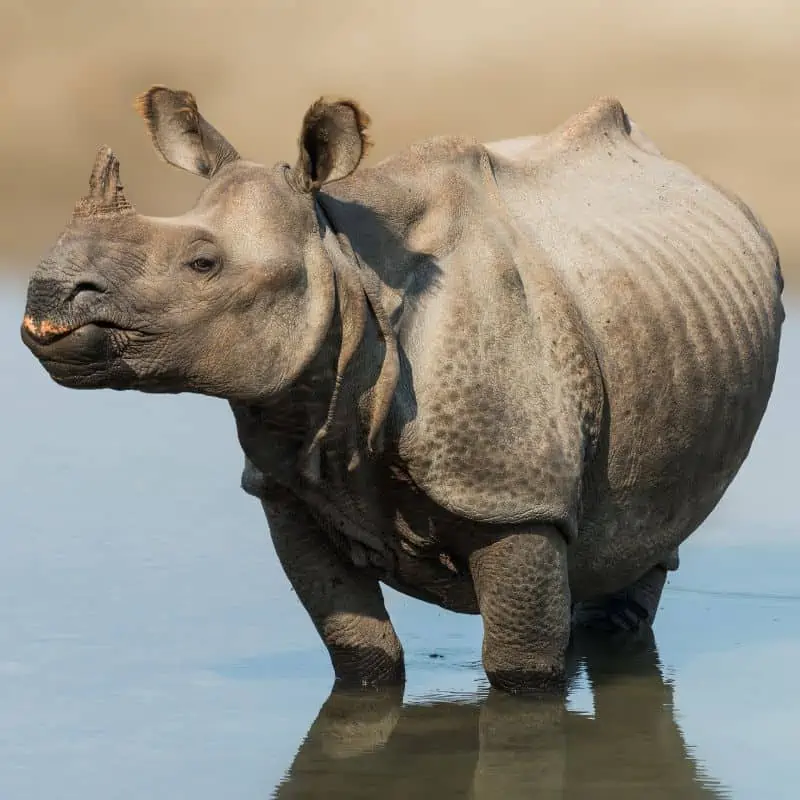When thinking about rhinos, the African savanna instantly comes to mind, and it’s hard to picture those mighty beasts living elsewhere. While that’s not entirely wrong, it’s not 100% correct either. So, where do Rhinos live?
Rhinos are divided into five species; only two live in Africa, while the other three live in Asia. You can find rhinos in South Africa, Kenya, Namibia, Zimbabwe, Cote d’Ivoire, Botswana, Zambia, Eswatini, India, Nepal, Indonesia, Borneo, and Sumatra.
Let’s look at the habitats these often gentle giants call home in more detail.

Where Do Rhinos Live in Africa?
The two rhino species that live in Africa are the black rhino and the white rhino.
Those two rhinoceros live mainly in South Africa, but in recent years, they’ve been reintroduced to other parts of Africa to preserve their numbers.
Currently, you’ll find the African black rhino all over Kenya, Namibia, and Zimbabwe, with 40% of its population in South Africa.
On the other hand, the white rhino has been reintroduced to Cote d’Ivoire, Botswana, Namibia, Kenya, Zambia, Eswatini (formerly Swaziland), and Zimbabwe.
Where Do Rhinos Live in Asia?
Asia is home to three species of rhinos, and these are:
- Sumatran rhino
- Greater one-horned rhino (or Indian rhino)
- Javan rhino
As the name suggests, the Sumatran rhino calls the islands of Sumatra and Borneo home. Additionally, the greater one-horned rhino lives in parts of India and Nepal.
Last but not least, the Javan rhino is found in only one region in Indonesia, which is a protected area on Java Island.

The Natural Habitat of Rhinos
As you can see, rhinos are spread over different parts of the world, so it makes sense that different species are accustomed to various habitats.
For example, those native to Africa live anywhere from grasslands to open savannas. In contrast, Asian rhinos live in a wider range of habitats.
You’ve got the Javan rhino, which prefers to stay in dense evergreen forests with access to water in the form of small rivers and swamps. Besides its importance as a drinking source, water also gives this rhino plenty of mud to roll around in.
Next up, there’s the greater one-horned rhino, it likes to stick to tropical and subtropical grasslands. You’ll also find it in savannas and shrublands in northeastern India and the southern parts of Nepal.
These habitats provide the rhino with everything its diet requires, from grasses to leaves to aquatic plants.
Lastly, the Sumatran rhino’s natural habitat is mainly in the form of lowland tropical and subtropical forests. You might also find it grazing on the dense highlands of Sumatra.
This rhino was once widespread over more parts of Asia, and it used to roam freely in eastern India, Thailand, and Myanmar. Scientists also believe that it spread as far as the Eastern Himalayas.
Now, the only place where you’ll find it is in Sumatra and Borneo.
Rhino Populations in Africa and Asia
When comparing the numbers of rhinos that once lived about a century ago and those living today, it’s hard not to feel sorry for what these animals have been through.
Rhinos used to be so much more widespread than they are now that they were also found in Europe and other parts of Asia and Africa. Cave paintings of Early Europeans are proof of that.
Around the 20th century, the population of rhinos in Asia and Africa was close to 500,000. Yet, from that point to 1970, that number had been reduced to a heart-wrenching 70,000, but that’s not even the most unfortunate thing.
Today, approximately 27,000 are alive in Africa and Asia, which is a mindblowing difference from the half-million population that existed a hundred years ago.
Of course, many human practices led to this insane decrease in rhino numbers, the main culprits being poaching and habitat loss.

Saving Rhino Numbers in Asia and Africa
Nowadays, this population of rhinos is spread over the regions we’ve already mentioned. Rhinos rarely live outside reserves, and many species are considered critically endangered. These include the Javan, Sumatran, and black rhinos.
Several foundations and organizations are doing their best to boost these numbers and rescue endangered species. Some of these efforts are paying off, as with southern white rhinos.
These rhinos were considered extinct, but they’ve been rescued and relocated to protected sanctuaries in different parts of Africa. Now, they’re labeled as near threatened, a far cry from their earlier classification.
Even the number of black rhinos has improved in the last two decades. Twenty years ago, there were only 2,500 rhinos in Africa, which has doubled.
Of course, the population of black rhinos now is still incomparable to what it was at the beginning of the 20th century. It was believed to be around 100,000.
Yet, we have faith in all the foundations that managed to raise those numbers in the past few years. With assistance, their efforts may help rhino populations worldwide go back to their former glory.
Final Thoughts on Rhino Habitats
To recap, different species of rhinos live in regions of Africa and Asia.
African rhinos are commonly found in South Africa, Kenya, Zambia, Botswana, Namibia, and more. On the other hand, Asian rhinos live in limited parts of Sumatra and Borneo, Java, India, and Nepal.
As for the natural habitat of rhinos, it varies depending on the species. It can be anything from tropical to subtropical grasslands, evergreen forests, shrublands, and open savannas.

